In St. Johns County, more than 55% of public school teachers paid their union dues this last year. Despite that, nearly 3,500 teachers face the threat of having their union representation revoked.
At the same time, in Southwest Florida, only 16% of law enforcement officers of the Charlotte County Sheriff’s Office paid union dues last year. Their union is under absolutely no threat of being decertified.
A year after Gov. Ron DeSantis signed into law a sweeping anti-union bill requiring most public sector unions to boost the rate of members paying dues or be disbanded, the full effects of the new union rules are coming into clear view — double standards and all.
Law enforcement, firefighter and correctional officer unions are exempt from the new law, no matter how few members pay union dues.
For other public sector unions, what is emerging is an outright crisis.
A labor economist warned the law could prove to be more effective in destroying labor power in Florida than the landmark Act 10 proved to be in Wisconsin, a law broadly considered as one of the strongest anti-union laws ever passed by a state government.
After reviewing hundreds of pages of state union recertification filings, WLRN can reveal that already several tens of thousands of workers have quietly lost their collective bargaining rights, a right that is explicitly protected by the Florida Constitution.
Unions representing tens of thousands of additional public sector workers across the state are in danger of being decertified and dissolved.
The numbers are not being tracked or published by the state or any labor organization, so WLRN requested the records and created a public database to track the fallout of the law.
Most affected employees perform core public sector jobs like teaching in schools, doing clerical work for state and local government, repairing engines and machinery for government agencies, answering 911 calls at call centers and working at city parks.
Public sector unions help negotiate everything from break times to purchasing new equipment to setting standards for general working conditions and laying out a process for discipline or termination of employees. Without a union to negotiate or enforce a collective bargaining agreement, those negotiated worker protections can be reversed.Some advocates fear that as collective bargaining agreements are threatened or are outright killed, it will affect how many people choose to work in the public sector, something that can directly impact public services for millions of Floridians.
A major impact on decades-old unions
Dozens of the at-risk unions have existed in Florida for decades, stretching back a full 50 years to 1974, when the Florida Public Relations Act required the state and local governments to negotiate with unions in good faith.
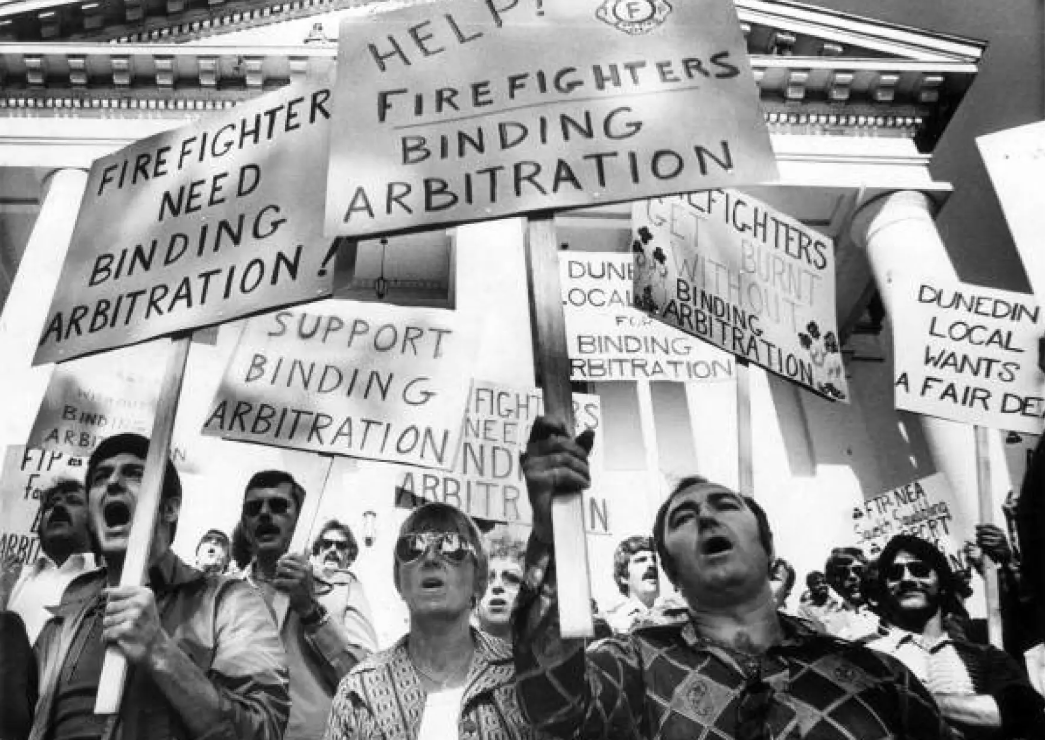
The full scope of the new law is still coming into focus, but it is abundantly clear that it will have a major effect on labor in Florida for the foreseeable future.
“The work conditions of hundreds of thousands of people are going to be up in the air,” said Rich Templin, the director of politics and public policy for the AFL-CIO Florida. “That’s real lives. That’s not politics. That’s not pro-union, anti-union — it’s none of that. People’s lives are going to be upended.”
The AFL-CIO is the largest labor organization in Florida, representing over 500 local unions across the state. The group stringently fought SB 256 from going into effect and is attempting to change small, technical parts of the 2023 law in the current legislative session. Templin concedes the proposed changes are around the margins, not at the heart of that law.
The sweeping law was proposed by Florida Republicans as a series of “paycheck protections” for public sector employees — protections that excluded police, firefighters and correctional officers. Unions would be forced to engage more with their members and would come out stronger in the end, they argued.
Yet many unions have not come out the other side stronger; they have simply been wiped out.
The scope of the potential fallout is difficult to put into words without becoming a massive, eye-blurring list.
Non-instructional staffers at the biggest public colleges in the state, including museum workers, grant writers, groundskeepers, teacher aides, secretaries and more have already fully been decertified, according to the state. The list includes staffers at Florida International University, University of Central Florida, Florida State University, University of Florida, University of South Florida, Florida Agricultural and Mechanical University, the University of North Florida and the University of West Florida.
Municipal workers in the cities of Oakland Park, High Springs, Naples, Jacksonville, Sebring, Bradenton and other governments have already had their unions fully decertified by the state.
Four separate Association of Federal State County and Municipal Employees bargaining units representing more than 42,000 State of Florida employees have been fully decertified.
Those bargaining units were at an impasse with the state government while trying to negotiate the next contract, Florida Senate records show. With the union fully decertified, the master contract between workers and the state has “no force and effect,” and no one has the authority to negotiate any new contract.
“All of these public sector servants — one of the draws to bring them into these jobs is because they have this security of a collective bargaining agreement,” said Templin. “When that’s gone, they’re gone. And when they’re gone, it’s not going to take long for average Floridians to feel it.”
The state has for years been operating with a crisis of job vacancies and struggling job recruitment efforts. Some state agencies were operating with as many as 1 out of every 4 jobs left unfilled last year, according to a Tampa Bay Times report.
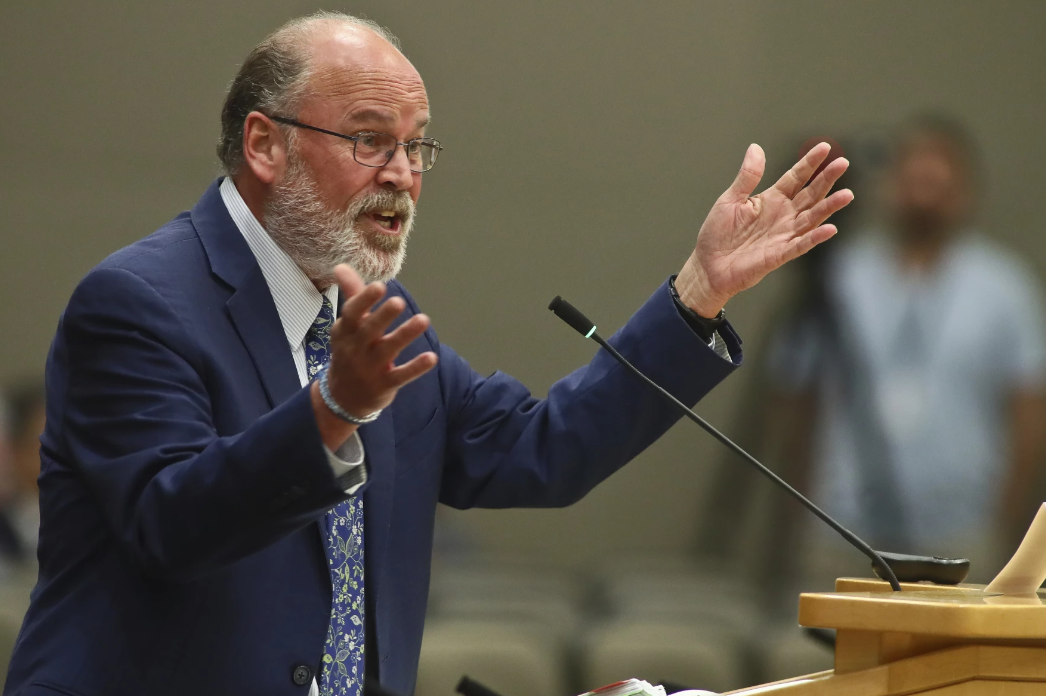
Under the new law, public sector unions — with the exception of law enforcement, firefighter and correctional officer unions — must meet the threshold of having at least 60% of members pay dues in order to stay active.
None of the cities, schools or departments listed above hit that threshold when required documents were filled with state.
If the threshold is not met, the unions have one month to collect “interest card” signatures from at least 30% of members, saying they would like to continue being represented by the union. If the signatures are collected and accepted by the Florida Public Employee Relations Commission, a new union election will have to be held to show a majority of eligible members still want to be represented by the union.
Unions that do not submit the 30% signatures or that fail the ensuing election lose their collective bargaining rights.
Perhaps most significantly, the law bans the state and local governments from automatically deducting union dues from paychecks, a standard practice often directly written into union contracts.
The law amounts to a double-whammy: It made it more difficult for members to pay dues while requiring more members to do so.
Cities and counties where units of municipal workers are potentially losing their right to collectively bargain include Miami-Dade County, Broward County, Surfside, Avon Park, North Port and Williston. Mechanics at the Orange County Sheriff’s Office are facing the same crossroads.
More than 700 municipal workers in the large South Florida city of Hialeah are pushing to keep their union alive, potentially affecting everyone from accountants, building inspectors, electricians, custodial workers, police radio dispatchers and more. Only 20% of eligible Hialeah workers were paying dues when a November filing was sent to the state.
Teachers’ unions among the most affected
Teachers unions are among the groups most affected by the fallout of the law. At least eight county teachers unions in Florida have failed to collect union dues from at least 60% of members, instantly throwing them into an uncertain future.
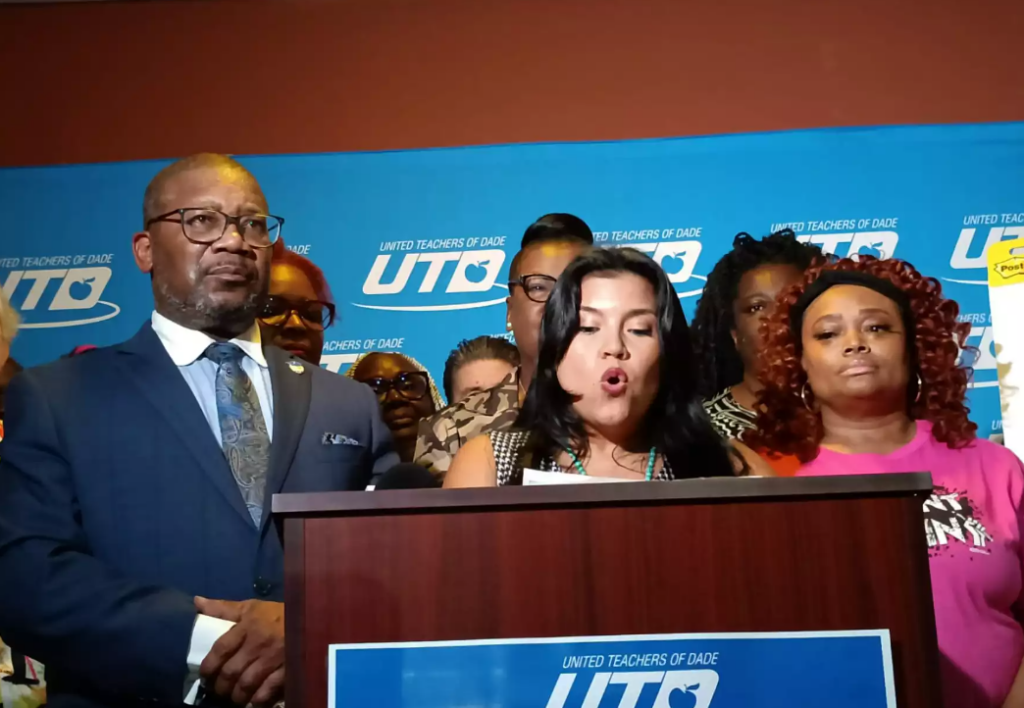
The teachers union for Miami-Dade County — United Teachers of Dade — was the very first public sector union recognized in the state in 1974, a history it bears with the state certification number 001. The union worked hard to increase its membership to comply with the new law, but fell short. Now, for the first time in its history, the union is forced to fight for its life, as just over 56% of more than 23,000 eligible members paid dues, according to the union’s filing.
In January the union handed in the recertification forms, and is awaiting a new union election date.
“I feel great about what we’ve accomplished. But also it’s bittersweet. Because why don’t they want us to have rights? The democracy seems to be slipping away out of Florida,” union member and school social worker Ruth Doriscar told WLRN. “It’s heartbreaking.”
Other large teachers unions are somewhere in the decertification process. Seminole County, for example, got only 52% of its 4,547 members to pay dues, a majority but short of a supermajority.
In St. Johns County, nearly 56% of its 3,490 members paid dues, casting doubt into the union’s future. In Escambia County, the home of Pensacola and the population center of the Florida Panhandle, only 51.5% of 2,656 paid dues.
Just last year, all a teachers union had to do was meet the threshold of 50% to stay active, a reality that was put in place only for teacher’s unions in 2018. Almost all teachers unions were able to stay intact under the 50% threshold, with the exception of Jefferson County, whose union was decertified and dissolved amid a state takeover of its public education system.
The 2023 law raised the bar to 60%, and applied it to many other public sector unions.
Through organizing and reallocating resources to sign members up for new methods of dues payments, some counties were able to get their numbers up significantly, enough to be safe at least until next year when the process will repeat.
Bay County went from 54% to 61% of 1,601 members paying dues, clearing the hurdle. DeSoto went from nearly 53% to 62%, safe for now.
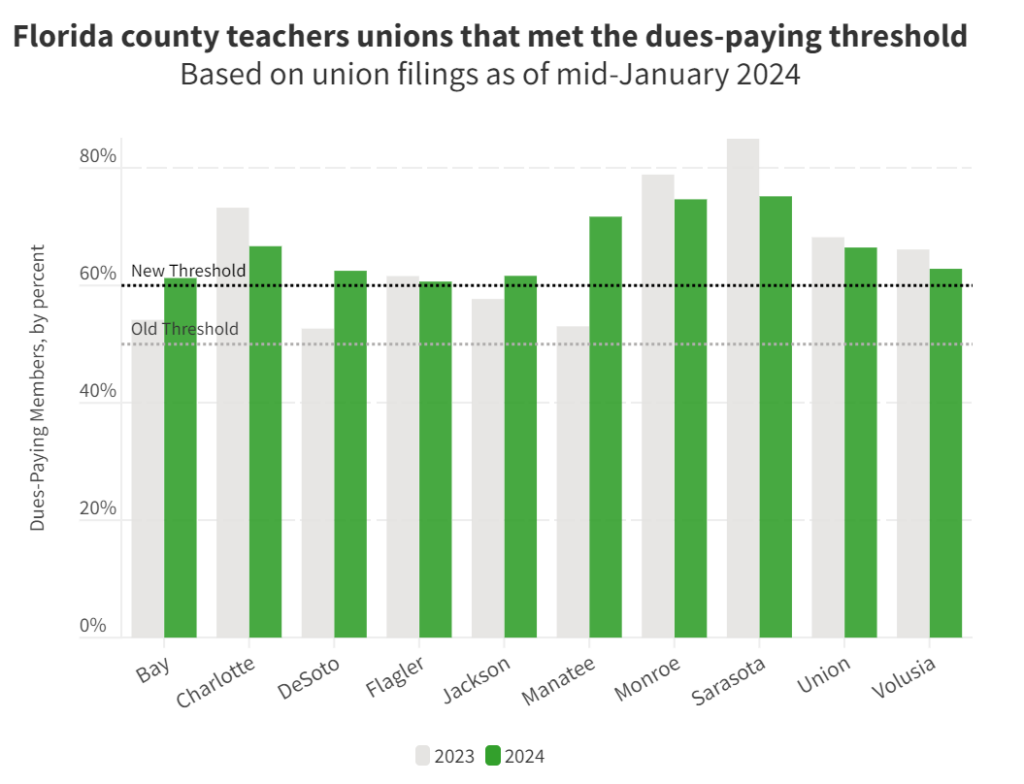
Manatee County in the Gulf Coast went from 53% to nearly 73% of members paying dues, a sharp increase. The union represents more than 2,800 employees.
“Our folks were amazing. It was really incredible how our rank and file people stepped up. I was very, very proud of what our folks did,” said Pat Barber, the longtime president of the Manatee Education Association.
The union’s contract with the school district turned 50 this year, Barber noted, and this was the first time it had to fight to stay alive. Even though the Manatee union appears safe for now, Barber is angry on behalf of thousands of other teachers who might lose union representation.
“It’s extremely disappointing to me that my colleagues are in that position because of an unfair law that’s been passed. They have a new challenge in front of them,” said Barber.
Many teachers don’t fully realize that the only reason they “have a defined work day, have a duty-free lunch, have time to plan during their workday” is because of contracts that were negotiated by unions, she said. Convincing members to pay union dues in a Right to Work state is a “daily challenge,” she added.
When the bill was being debated last year, sponsor Sen. Blaise Ingoglia, a Spring Hill Republican, said the point of his proposal was to foster more engagement between membership and unions, and that unions would become stronger in the end, as more members pay dues and get involved.
Even though the Manatee teachers’ union gained a significant number of teachers paying dues, Barber said it does not make the group feel any stronger.
“I do not feel that having a guillotine over the union’s head is an incentive to be stronger and more organized,” said Barber. “It’s a threat to our folks.”
Ocala union counting down the days
The International Brotherhood of Electrical Workers Local 1205 has represented more than 400 municipal workers in the city of Ocala since 2013, a group including crime scene technicians, electric system operators, park workers, code enforcement officers and more.
When the union filed its recertification with the state in mid-January, just 41 out of 465 members were listed as paying dues of $47 a month. The tiny number does not just put the bargaining unit at risk, it might well kill the union.
“To be honest with you I’m very sad. We have members there that need union representation,” said Nelson “Lanny” Mathis Jr., a business manager of the IBEW union who has been a member of Local 1205 for over four decades.
READ MORE: As Florida’s new union law goes into effect, it’s ‘do or die’ time for labor
Organizing a campaign to gather signatures for recertification, then running a campaign for a future vote is simply not practical when it comes to deciding how and where to allocate resources for a local that mostly represents private sector workers. Especially not when the union might have to repeat the process again next year and the year after that.
“I think there’s no great buy-in to reorganize, and I’m just afraid that there’s nothing we can do,” Mathis told WLRN. “I don’t believe it was ever directed at people like the city of Ocala. I think those guys got caught in the crossfire.”
The justification presented by Republican lawmakers who passed the law — including Gov. DeSantis — was that SB 256 was intended to “protect” the paychecks of workers. Yet the law carved police and firefighters out of those “paycheck protections.” Those unions represent some of the Republican governor’s most vocal supporters.
Teachers’ unions, on the other hand, have emerged as one of the most vocal opponents of DeSantis and the Republican-dominated government. The governor specifically mentioned the impact on teachers’ unions at the news conference when he signed the law.
Mathis said Ocala city officials have told him they intend to honor the collective bargaining contract through September, when it expires. When it comes time for negotiating the next contract, the workers simply might not have representation asking for higher pay or better benefits, he lamented.
A total of 6.1% of Florida workers were unionized in 2023, a slight uptick from the previous year. Florida’s overall unionization rate reached as high as 8.7% of ITS workforce in 2000, the first year the federal government began tracking the data, and it has slowly wobbled downward ever since.
If any significant portion of the at-risk union members lose representation through decertification this year, it could represent a steep and abrupt drop in Florida’s union membership rate.
With the new union law in effect, Mathis fears the working class in Florida faces a bleaker future.
Workers who are unionized make significantly higher wages than those who are not, according to the U.S. Bureau of Labor Statistics. They also have significantly higher insurance and retirement benefits.
“Last year was the worst I’ve ever seen. I’ve been involved in politics since 1980, in one form or another,” said Mathis. “It used to be they’d hide stuff from you, they do it behind your back, they do it under the table. They don’t even give a damn anymore. They’re just right out there in the sunshine, man.”
“It has literally gotten to the point where they know we can’t stop ‘em,” he said.
An early but troubling picture
The new law’s effect on public sector unions is just now coming into focus, but even then it is an early picture.
Public sector unions have been required to send the state information about how many members pay dues only since last October, when that section of the law went into effect. But different unions have different dates when they need to send in the paperwork.
Since that’s the case, WLRN’s findings cannot reflect paperwork that has yet to be submitted, from February through September 2023. The number of affected unions will only grow. While in theory some unions might be able to rally their members, it seems likely the fallout will be devastating and increasingly worse for labor.

The Association of Federal State County and Municipal Employees declined to be interviewed for this story, but dozens of locals represented by the group are already at risk of being decertified. Nationally, AFSCME represents over a million public sector workers, including tens of thousands in Florida.
In a statement to WLRN, the group said it remains committed to protecting the “rights, freedoms and voice” of public sector workers.
“We are still exploring all options on how best to do that, local by local, as we continue the implementation and unintended consequences of this anti-worker law,” the union said. “We look forward to ensuring that AFSCME members continue to be a strong force for quality public services and economic equality in the years to come.”
In the state lawsuit filed to push back against the law, the union claims that the law “destroys the foundations upon which Florida is a ‘Right to Work state,” where employees that benefit from collective bargaining agreements are not required to pay union dues.
Before the 2023 law, even if workers did not pay dues, so long as a voting majority agreed to be represented by a union in contract negotiations, the union survived.
The state has not yet responded to an amended complaint filed by AFSCME in December 2023, but the union failed to temporarily block the law before it went into effect.
‘Even more targeted’ than Wisconsin’s landmark precedent
The AFSCME union was created in 1932 in Wisconsin, the state where public sector collective bargaining was born. But a broad 2011 law from that state was frequently cited in interviews as paving the way for Florida’s new public sector union law.
That landmark 2011 Wisconsin law, known as Act 10, shifted the attitudes of many state governments toward public sector unions. Yet Act 10 required only an annual majority vote of total members to keep a union alive, not for any specific number of members to pay dues.
Laura Dresser, a labor economist at the University of Wisconsin-Madison, told WLRN that SB 256 appears to be stronger than Wisconsin’s law and predicted that its impact might be more widespread and immediate.
“In some ways it feels even more targeted — to undermining the ability of unions to continue existing in Florida,” said Dresser. “That 60% dues bar feels really stringent to me.”
After the 2011 bill was signed into law by Republican Gov. Scott Walker, the amount of workers represented by unions in Wisconsin dropped dramatically. Between 1989 and 2011, a larger percentage of Wisconsin workers were represented by unions than the national average. Ever since 2012, the state has dropped well below the national average, according to a study done by the University of Wisconsin-Madison. The former union stronghold state has seen the largest drop of union membership in the nation since 2000, in large part due to Act 10.
An estimated 100,000 people showed up at the state Capitol to protest the 2011 proposal, owing to the state’s history as a longtime union stronghold. Police and firefighter unions were exempted by the law, but many protested in solidarity with fellow unions.
On top of requiring an annual vote on continued representation, the Wisconsin law also banned union dues from being directly reduced from paychecks for most public sector unions, a step Florida has taken. Act 10 also narrowed the scope of what unions could bargain for, limiting it to basic pay. Florida’s law does not limit what unions can negotiate. Wisconsin union members were also forced to pay a greater share of retirement benefits, something Florida’s law does not touch.
Overall, the effect has been that Wisconsin public sector unions have been perpetually put on the back foot, struggling to survive and to stay relevant in political decision-making, said Dresser. The impact has been that real wages for public sector workers like teachers have significantly dropped.
Republican lawmakers, on the other hand, boast that the measure saved taxpayers billions of dollars.
“Public sector unions were deeply undermined and became much less relevant inside work sites and inside the state political discussion,” said Dresser. “That’s what happened in Wisconsin; that’s what I expect may come to Florida.”
A major difference between Wisconsin and Florida is that unlike Wisconsin, Florida explicitly protects the right to collectively bargain in the state Constitution. Dresser said that could prove a crucial element in legal challenges to the law.
“What does it mean to offer people a right to collectively bargain when the rules around the union you have that would carry the voice that would enforce or actualize that right are so constrained that they can’t operate?” asked Dresser. “There’s a deep tension there about how you can make that right, real.”
For unaffected unions, like those for law enforcement and firefighters, those collective bargaining rights remain unchanged. The Town of Bellaire, in Pinellas County, listed only 35% of officers paying dues in its recertification, but that union is under no threat of being decertified.
Likewise, the Town of Indian Shores, also in Pinellas, listed only 33% of members paying dues. That union is also completely safe from decertification.
Under SB 256, any public sector union that is in the process of being decertified needs to hold a new election to show a majority of eligible members still want to be represented by the union. If the vote fails, the union is fully decertified. Affected unions could be forced to hold these votes every single year if they do not hit 60% of eligible members paying dues, just to stay alive.
No recertification elections have been called just yet, but the Florida government is allocating additional resources to prepare for a huge uptick in these elections. In DeSantis’ proposal for the 2024-2025 budget, he lists nearly $1.5 million in additional funding for the Florida Public Employee Relations Commission (PERC) — taking it up to $6,517,821.

‘Rolling with the punches’
Calhoun County, in the Florida Panhandle, was the very last of Florida counties to organize a teachers union, in 2016.
Last year, state data shows 51.7% of teachers there paid union dues; after the law went into effect, that number dropped to 32.78%, calling the union’s future into question.
Brian Gay, the Calhoun union president, hung up the phone on WLRN when contacted to ask about how the union might respond, and he said he did not want to be further contacted.
Citrus, Columbia and Highlands County teachers’ unions were past the 50% threshold, but under 60%, setting the decertification process in motion. The unions represent teachers on the Gulf Coast, in North Central Florida and in South Central Florida.
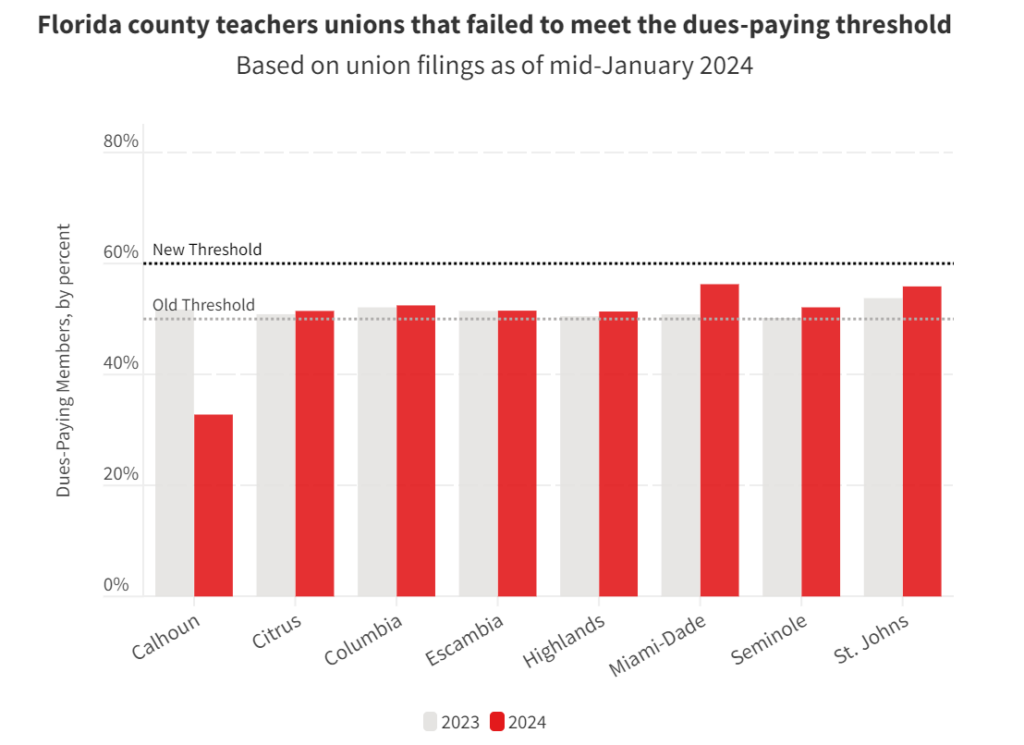
“We’re rolling with the punches,” said Christian Gallery, the president of the Citrus County Education Association. “We’re still doing the work that needs to get done. We actually got one of the highest raises in a long time, even as we were fighting the recertification battle back in October. But we’re still doing what we need to do.”
The Citrus union represents 1,170 teachers, along with 627 non-instructional staff in a separate contract. The teachers’ union had 51% of members paying dues, while non-instructional staff only had 29%, according to public filings. Both bargaining units already gathered and submitted the needed signatures to run a recertification election.
“Was that annoying? Was that a process that I would have rather not had to do, and everyone involved would have rather not had to do? Absolutely. But we got it done,” he said.
Gallery said hopes are high about keeping the union alive. He is counting the number of members paying dues one by one, listing four added dues-paying members in a single week as a signal of progress towards hitting the 60% threshold.
In the big picture, said Gallery, public employees are losing rights enshrined to them in the Florida Constitution. The state Constitution was written in 1968, which happened to be the year Florida teachers went on strike statewide, demanding higher pay. It was the nation’s first statewide teacher strike.
The basic deal reached in 1968, said Gallery, was that teachers would agree to constitutional provisions banning public employees from striking, so long as they explicitly gained the right to unionize and collectively bargain. The 2023 law represents a retreat from that bargain, he said, and warned it could well lead to labor unrest.
“If people feel that teachers should maintain their status of not being allowed to strike, then they should also maintain their status of unfettered collective bargaining,” said Gallery. “I think people need to remember that, and act accordingly.”
You can access WLRN’s searchable public database tracking how the law is affecting unions throughout Florida here. The data is not comprehensive and will be updated.
Lead image: Members and staff of AFSCME Local 199 held a drive in June 2023 to get the amount of dues paying members past the 60% threshold created by a new Florida law. If unions fail to reach that threshold, they can be decertified and dissolved. | Daniel Rivero, WLRN
WLRN recently created an investigative reporting team comprised of reporters Danny Rivero and Joshua Ceballos, and two editors, Jessica Bakeman and Sergio R. Bustos. WLRN is a nonprofit newsroom that relies on your donations to fund their work and undertake stories like this one. You can donate here.






9(MDEwNzczMDA2MDEzNTg3ODA1MTAzZjYxNg004))

